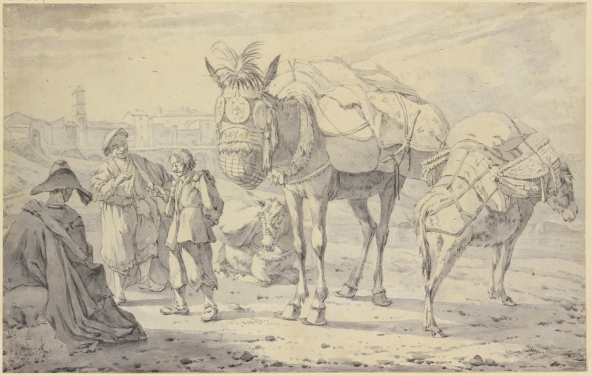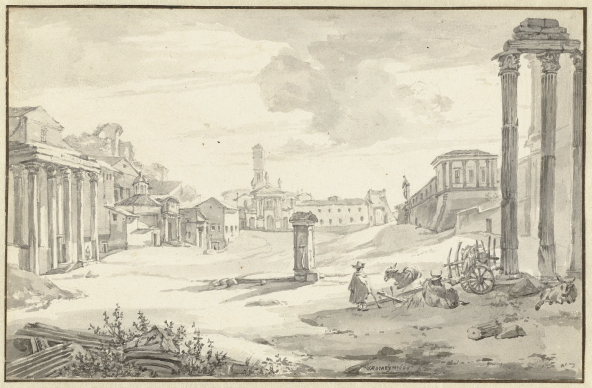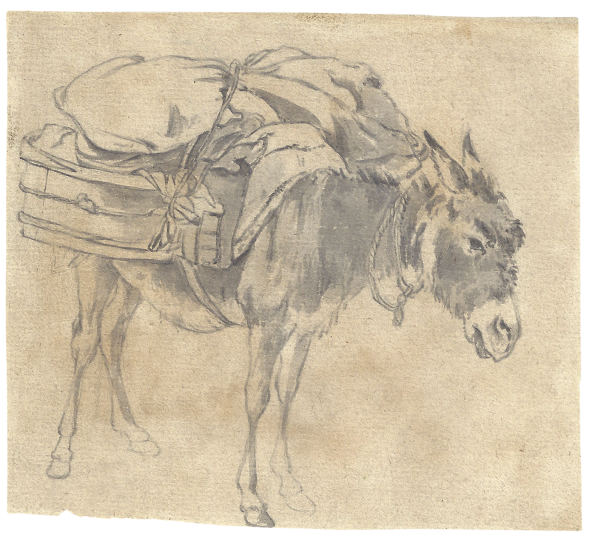Choose a background colour
Willem Romeyn, Dutch, c. 1624-c. 1695: Boy with Two Laden Donkeys in the Hills, 1694
Black chalk and gray wash on paper; framing lines in brown ink, with two additional lines in black chalk along the top and right edges.
7 11⁄16 × 12 11⁄16 in. (19.5 × 32.2 cm)
Recto, upper left, in black chalk, signed and dated, WROMEYN 1694; verso, center, in pencil, B.4., at lower left, in light brown ink, XVI, and to the right, in pencil, Romeyn.W.van1624-.
- Chain Lines:
- Horizontal, 25 mm.
- Watermark:
- Countermark MCMD.
- Provenance:
Sale, Amsterdam, Christie’s, 26 November 1984, lot 103; Sheldon and Leena Peck, Boston (Lugt 3847); gift to the Ackland Art Museum, inv. no. 2017.1.72.
- Literature/Exhibitions:
F. Robinson in Chapel Hill, Ithaca & Worcester 1999 – 2001, 84 – 85, no. 25.
- Ackland Catalogue:
- 2017.1.72
Willem Romeyn enjoyed a fifty-year-long career painting and drawing Italianate subjects. In his twenties, the artist traveled to Italy and worked in Rome from 1650 to 1651 under the Italianized name Guglielmo Romano. During this short period, he amassed a large stock of studies from life that he later used to generate finished compositions in his studio in Haarlem. Here, donkeys heavily laden with gear stop at the side of a trail in a remote hilly location, attended by a young boy. Romeyn’s skillful use of washes to define texture, as seen in the pack animal’s shaggy coats, and the effects of intense sunlight, bring a sense of verisimilitude to this imagined moment.
Although he remains little studied, Willem Romeyn had a long career painting and drawing Italianate subjects, primarily in Haarlem, where he also served prominently in the local guild.1
Romeyn’s style stayed remarkably consistent over his five-decade career, revealing the enduring influence of his master, Nicolaes Berchem (1621/22 – 1683), with whom he studied between 1642 and 1646.2
Since they were only a few years apart in age, Berchem and Romeyn are better considered as contemporaries, both belonging to the so-called Second Generation of Dutch Italianates. In contrast with Berchem, however, we actually have evidence that Romeyn made the trip south of the Alps since he is recorded living and working in Rome under the Italianized name of Guglielmo Romano in the years 1650 – 51. He was back in Haarlem by 1652.3
Romeyn executed a large number of drawings over the course of his career, though a significant portion of these date to the early 1690s, including the present work.4
They demonstrate his undiminished strength as a draftsman later in life. Most are likewise signed and finished works in his preferred combination of black chalk and gray wash. Romeyn inherited Berchem’s skillful care in his use of washes to define texture, form, and the luminous effects of sunlight, all of which can be seen to great effect in the Peck drawing. In this work, Romeyn skillfully contrasted the shaggy coats of the pack animals with the various textures of the sacks and the wicker gear loaded onto them. The boy facing away from us remains anonymous and hidden in his cloak, standing at rest in a remote and hilly location with his charge. That the pack animals face in opposite directions seems to indicate that their stop by the side of the trail was more than a momentary one.
Like many of his fellow Dutch Italianates, Romeyn enjoyed depicting travelers in various landscapes, especially those with ancient ruins in the background. By contrast, Romeyn’s focus here is almost solely on the boy and his pack animals, with only a few suggestions of a landscape. He rarely depicted figures and animals so near and with such care, but this work relates to three other drawings in which Romeyn did so, all signed and dated 1694, and all similar in format and dimensions as well as subject matter.5
The drawing from Frankfurt in this group juxtaposes a mule (wearing the medallion blinders) with the slightly smaller donkey to the right Fig. 66.1.

Willem Romeyn, Figures with a Donkey and Mule, 1694. Black chalk and gray wash, 209 × 329 mm. Frankfurt, Städel Museum, inv. no. 849.
bpk Bildagentur/Städel Museum, Frankfurt am Main, Germany/Art Resource, NY
It is possible that the artist intended a similar contrast between a mule and a donkey in the Peck drawing, though the exact identification of the animal at the center is difficult to determine beneath the bulky load it carries. In general, these compositions appear to have been inspired by Karel du Jardin (1626– 1678), a fellow Dutch Italianate, and possibly also a fellow student of Berchem’s in the 1640s. Du Jardin was fond of featuring pack animals such as these in his paintings and etchings from the early 1650s onward.6
One of the characteristic features of Romeyn’s working method is the reuse of figures and other motifs in his drawings and paintings across the span of his career. The standing boy with his walking stick in the present work, for example, appears in exactly the same pose in a drawing from over three decades earlier, View of the Roman Forum, dated 1660 Fig. 66.2.7

Willem Romeyn, View of the Roman Forum, 1660. Gray wash on paper, 155 × 240 mm. Amsterdam, Rijksmuseum, inv. no. RP-T-1905-207.
Rijksmuseum, Amsterdam
Likewise, the slightly more distant donkey in the left middle ground of the present sheet features in the same pose and aspect in two other drawings.8
Romeyn obviously kept a large stock of studies from life, especially those made during his years in Italy, from which he could generate finished compositions in the studio. While his life studies generally do not survive, one such example might be a study for the foreground donkey on the right that was recently on the art market Fig. 66.3.9

Willem Romeyn (attributed to), Study of a Laden Donkey. Black chalk and gray wash on paper, 118 × 135 mm. Present whereabouts unknown.
Courtesy Foolscap Fine Art
Peter Schatborn demonstrated that Romeyn not only recycled figures and motifs, but also larger views of Rome and its ruins as well.10
Such a procedure certainly exemplifies the vital impact of drawing as a practice for artists who visited Rome for only a short portion of their working career. Romeyn possessed an impressive ability to inventively and seamlessly recombine his studies to create lively original compositions such as this one, in which the convincing qualities of subject and place belie the imaginary nature of the representation.
End Notes
For an overview of Romeyn’s drawings, see P. Schatborn in Amsterdam 2001, 147 – 51; and Knab 1964 for an introduction to the artist. Knab’s main goal in his article was to posit that an important group of drawings of Roman subjects in Kassel is by Romeyn’s hand, but Lisa Oehler suggested Willem Schellinks in a subsequent and more thorough study of the group (Oehler 1997). Both suggestions have been thoroughly refuted; see Steland 1999, who suggests instead an anonymous follower of Jan Asselijn. Romeyn served as vinder or oudvinder in the guild three times (1660, 1661, 1677) and was nominated on three other occasions (1670, 1671, 1676); for which see the relevant entries in Miedema 1980.
See Miedema 1980, vol. 2, 543, for his registration as one of Berchem’s first three students in the guild records. For his acceptance into the guild as master in 1646, see idem, vol. 2, 1040, sometimes given incorrectly as 1644.
Hoogewerff 1942, 123 – 24. He is listed twice in the stati delle animé of the parish of San Lorenzo in Lucina as Guglielmo Romano, first as pittore fiamengo, and then as olandese, pittore. He does not appear to have been a member of the Bentvueghels there, nor (if so) has his Bent-name survived; see Hoogewerff 1952, 77.
For some of Romeyn’s other drawings from the early 1690s, see White & Crawley 1994, 298 – 99, nos. 430 – 33; Stefes 2011, 472 – 73, nos. 876 – 77; and Plomp 1997, 352 – 53, nos. 404 – 05.
The other three drawings are those in the Städel Museum, Frankfurt, inv. no. 849; the Courtauld Gallery, London, inv. no. D.1952.RW.2039; and formerly in the Einar Perman collection, Stockholm. This cohesive group was first established by F. Robinson in Chapel Hill, Ithaca & Worcester 1999 – 2001, 84.
For similar paintings in Du Jardin’s oeuvre, see Kilian 2005, passim; and for examples among his etchings, which may have arguably had greater impact, see Hollstein, vol. 6, 22 – 47, especially nos. 2, 6, and 27.
See P. Schatborn in Amsterdam 2001, 148, fig. B. The same dilapidated oxcart to the right of the boy in this drawing was likewise exactly repeated decades later in a drawing dated 1693 in the Teylers Museum, Haarlem; see Plomp 1997, 352, no. 404.
Paris, École Nationale Supérieure des Beaux-Art, inv. no. Mas.1944 (Lugt 1950, 64, no. 515); and Hamburg, Hamburger Kunsthalle, inv. no. 22437 (Stefes 2011, 473, no. 877). This particular repeated motif was first spotted by Sheldon Peck (email to Mark Broch, 4 December 2012, printed copy in curatorial files, Ackland Art Museum).
This drawing was offered for sale in 2012 by Foolscap Fine Art, The Hague. The study appears to have been done from life, though it is also possible that it copies an earlier study by Romeyn.
Amsterdam 2001, 147 – 51.
